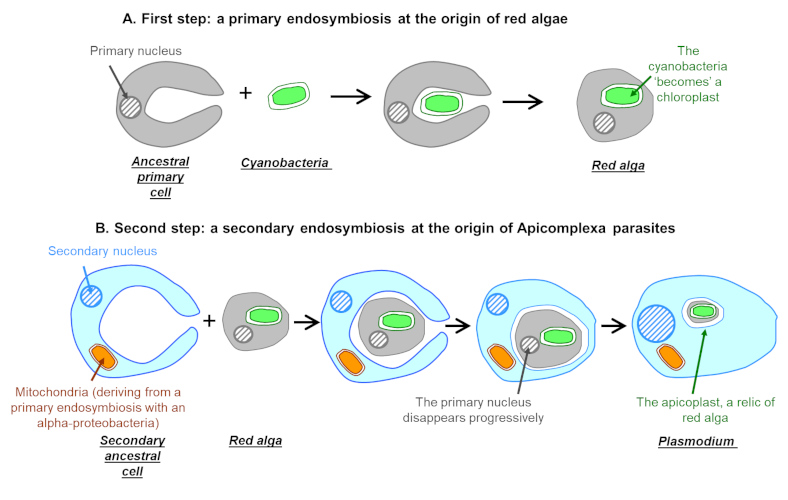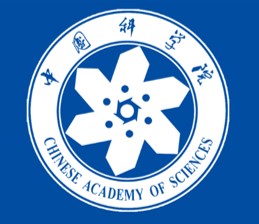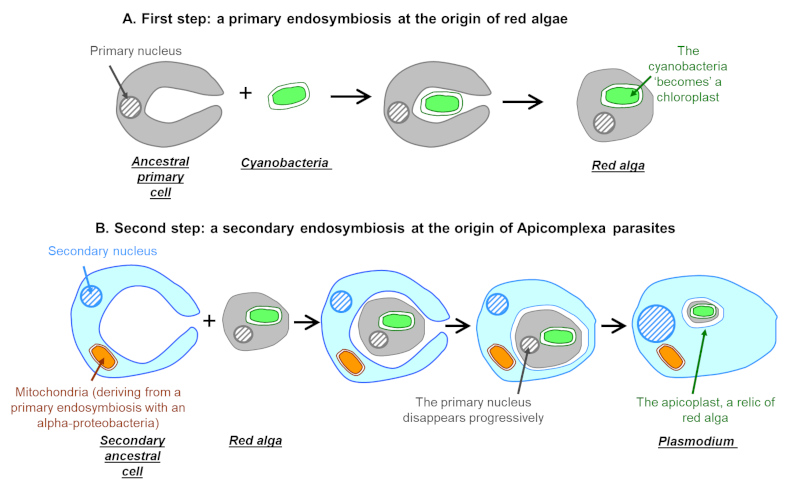恶性疟原虫,一种来自藻类的寄生虫
PDF
二十多年前,研究人员惊讶地发现,在引起疟疾的病原体疟原虫的细胞内存在一种结构,之前只知道这种结构存在于植物和藻类中:一个质体 [1]、[2]。然而,这个肢体不是绿色的,它不含叶绿素。进化中的什么重大事件可能导致叶绿体成为疟原虫细胞的组成部分之一?让我们回到进化:进化:具有细胞核的细胞(称为真核细胞)包含简单的细胞器、线粒体和叶绿体,它们是在称为“初级”的内共生过程中形成的(参见共生和进化)。 系统基因组分析表明,所有“初级”叶绿体的起源都是单一的初级内共生:当一个细胞“吞食”了一个可能与其他微生物混合的祖先蓝藻时。图A显示了红藻是如何形成的。目前的生化和结构数据表明,限制祖先蓝藻的两种膜很可能位于叶绿体包膜中两种膜的起源处。然后发生了一种新的内共生——称为“次级”,一个藻类被一个所谓的次级真核宿主“吞食”(图 B)。然后形成嵌套藻类的细胞,就想俄罗斯套娃一样。然后摄入的藻类被减少到仅留下一个被四层可见膜包围的质体的程度。疟原虫质体——被称为质体样细胞器——是这些事件之一的结果,分子数据表明它来自红藻。内共生有益于嵌套细胞,并在整个进化过程中一直保持。到目前为止,疟原虫祖先内部的代谢联系已经得到巩固,并且这种关联已变得密不可分。为了结束这种结合,来自红藻细胞核和质体的重要 DNA 区域迁移到了第二宿主的细胞核。由于这种细胞内含和DNA 掺入过程,疟原虫在其核基因组中包含数百个编码最初摄入的红藻蛋白质的基因。至于质体样细胞器,则是这种红藻的化石遗迹。
参考文献和说明
封面图片:[来源:©国家过敏和传染病研究所(NIAID) (恶性疟原虫) (CC BY 2.0) 通过Wikimedia Commons; 图片A&B来源: ©埃里克·马雷夏尔(Eric Maréchal)]
[1] McFadden GI, Reith ME, Munholland J & Lang-Unnasch N. (1996) Plastid in human parasites. Nature 381, 482.
[2] Kohler S, Delwiche CF, Denny PW, et al (1997) A plastid of probable green algal origin in Apicomplexan parasites. Science 275, 1485-1489.
[3] Biot C, Botté CY, Dubar F & Maréchal E. (2012) Malaria: Research into new therapeutic treatments targeting the apicoplast, a cellular organelle of algal origin. Med Sci. 28: 163-171.
Plasmodium falciparum, a parasite derived from an algae
PDFEric Maréchal, CNRS Research Director, Laboratory of Cellular & Plant Physiology, Université Grenoble Alpes.
More than two decades ago, the researchers were surprised to discover inside the cells of the malaria-causing agent, Plasmodium, a structure that until then had only been known in plants and algae: a plastid [1],[2]. However, this one is not green, it does not contain chlorophyll. What major event in Evolution could have caused a chloroplast to become one of the components of Plasmodium cells? Let us go back to evolution: evolution: cells with a nucleus (called eukaryotic cells) contain simple organelles, mitochondria and chloroplasts, formed during a process of endosymbiosis called “primary” (see Symbiosis and evolution). Systematic genome analysis shows that a single primary endosymbiosis is at the origin of all “primary” chloroplasts: when a cell has “swallowed” an ancestral cyanobacterium, possibly mixed with other microbes. Figure A shows how red algae was built. Current biochemical and structural data indicate that the two membranes that limited the ancestral cyanobacteria were likely at the origin of the two membranes in the chloroplast envelope. Then a new endosymbiosis – called “secondary” – occurred, which saw an alga “swallowed” by a so-called secondary eukaryotic host (Figure B). A cell is then formed nesting the algae, like a Russian doll. Then the ingested alga was reduced to the point of leaving only a plastid surrounded by 4 visible membranes. The Plasmodium plastid – called apicoplast – is the result of one of these events, and molecular data show that it is derived from red algae. Endosymbiosis has benefited both nested cells and has been maintained throughout the evolution. To the point that the metabolic links within the ancestor of Plasmodium have been consolidated and that this association has become inseparable. To conclude this marriage, important regions of DNA from the nucleus and plastid of the red algae migrated to the nucleus of the secondary host. As a result of this process of cellular inclusion and DNA incorporation, Plasmodium contains in its nuclear genome hundreds of genes that code for proteins originating from the red algae initially ingested. As for the apicoplast, it is a fossil relic of this red algae.
References and notes
Cover image. [Source: © NIAID (Plasmodium falciparum parasite) (CC BY 2.0) via Wikimedia Commons; source Figures A & B: © Eric Maréchal]
[1] McFadden GI, Reith ME, Munholland J & Lang-Unnasch N. (1996) Plastid in human parasites. Nature 381, 482.
[2] Kohler S, Delwiche CF, Denny PW, et al (1997) A plastid of probable green algal origin in Apicomplexan parasites. Science 275, 1485-1489.
[3] Biot C, Botté CY, Dubar F & Maréchal E. (2012) Malaria: Research into new therapeutic treatments targeting the apicoplast, a cellular organelle of algal origin. Med Sci. 28: 163-171.







